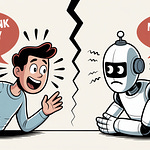Title: Deep Residual Learning for Image Recognition
Subtitle: When your neural net gets stuck, give it a shortcut.
Authors: Kaiming He, Xiangyu Zhang, Shaoqing Ren & Jian Sun
Published: December 10, 2015 (arXiv pre-print; camera-ready in CVPR 2016)
🐺 The Wolf’s TL;DR
Problem: Very deep nets should be great, but adding layers made training worse (vanishing gradients).
Hack-that’s-not-a-hack: Insert “skip connections” so each stack of layers learns only the left-over (residual) you couldn’t model yet.
Result: 152-layer ResNets crushed ImageNet 2015 (3.57 % top-5 error) and became the go-to backbone for vision, speech, even large-language-model encoders.
Why you care: Modern CV models—Mask R-CNN, CLIP’s vision tower, Diffusion UNets—all rely on residual blocks. No ResNets ➜ no stable, day-to-day generative-AI memes.
Why it mattered then (and still does)
Training depth-100+ networks was like stacking Jenga blocks in an earthquake. ResNet’s identity shortcuts keep gradients flowing, letting researchers build taller “skyscraper” models without them crumbling. That single architectural tweak unlocked today’s habit of “just make it deeper.”
How it shapes AI today
Computer vision backbones: From autonomous-driving perception stacks to your phone’s portrait mode, residual blocks are everywhere.
Diffusion & GAN generators: UNet-style up-and-downsampling chains use residual blocks to keep image details coherent—your DALL·E selfies thank them.
Language & audio models: Conformer (speech), T5’s encoder, even some LoRA adapters borrow residual pathways because stable gradients work cross-modality.
Hardware co-design: GPUs/Tensor Cores got optimized for dense residual ops, influencing NVIDIA’s architecture roadmaps.
For your writing toolbox
When explaining AI “depth,” ResNet offers the perfect metaphor: progress doesn’t always mean starting over—sometimes you just need a good shortcut. Feel free to riff on that in DROIDS or Deep Learning with the Wolf.
Read the full paper from the original authors.
🎧 Podcast Note
Today’s audio segment was produced with Google NotebookLM’s “Audio Overview” tool, so the two chipper voices you hear are 100 % synthetic. At one point they riff about “fixing a crooked nose on a stick-figure sketch” (listen around the 03 min 30 sec mark in the transcript above). The gag is delightfully meta: neither host has a face—let alone a nose—yet they’re swapping art tips as if they do. It’s a playful reminder that these are AI narrators explaining an AI paper, and sometimes the metaphors get more human than the humans. Enjoy the banter, and let me know if the bots made you smile!
Sources for this article and the podcast- created using Google NotebookLM:
Original arXiv pre-print (first public version, Dec 10 2015)
https://arxiv.org/abs/1512.03385
Microsoft Research publication page (official summary, BibTeX, slides)
https://www.microsoft.com/en-us/research/publication/deep-residual-learning-for-image-recognition/
Microsoft blog announcing the ImageNet win (good lay-reader context)
https://blogs.microsoft.com/ai/microsoft-researchers-win-imagenet-computer-vision-challenge/
Wired feature on “ultra-deep” ResNets (press coverage you can quote)
https://www.wired.com/2016/01/microsoft-neural-net-shows-deep-learning-can-get-way-deeper/
















Share this post